
RYA Powerboat Courses
Our rya powerboat courses.
Our Rib is a 6-metre Humber with a new Mercury 115 hp engine and Garmin plotter. She is coded and an excellent sea vessel.
Being in the heart of Lowestoft and right by the busy marine and port entrance there are ample practical teaching opportunities
INSTRUCTOR – STUDENT RATIO Either 2:1 or 3:1.
What’s included
- You will be coached over the full RYA course syllabus
- Tea and coffee plus yummy biscuits
- RYA Start powerboating book
- SPBT note book
- Free Parking
- All mooring fees, safety equipment and fuel
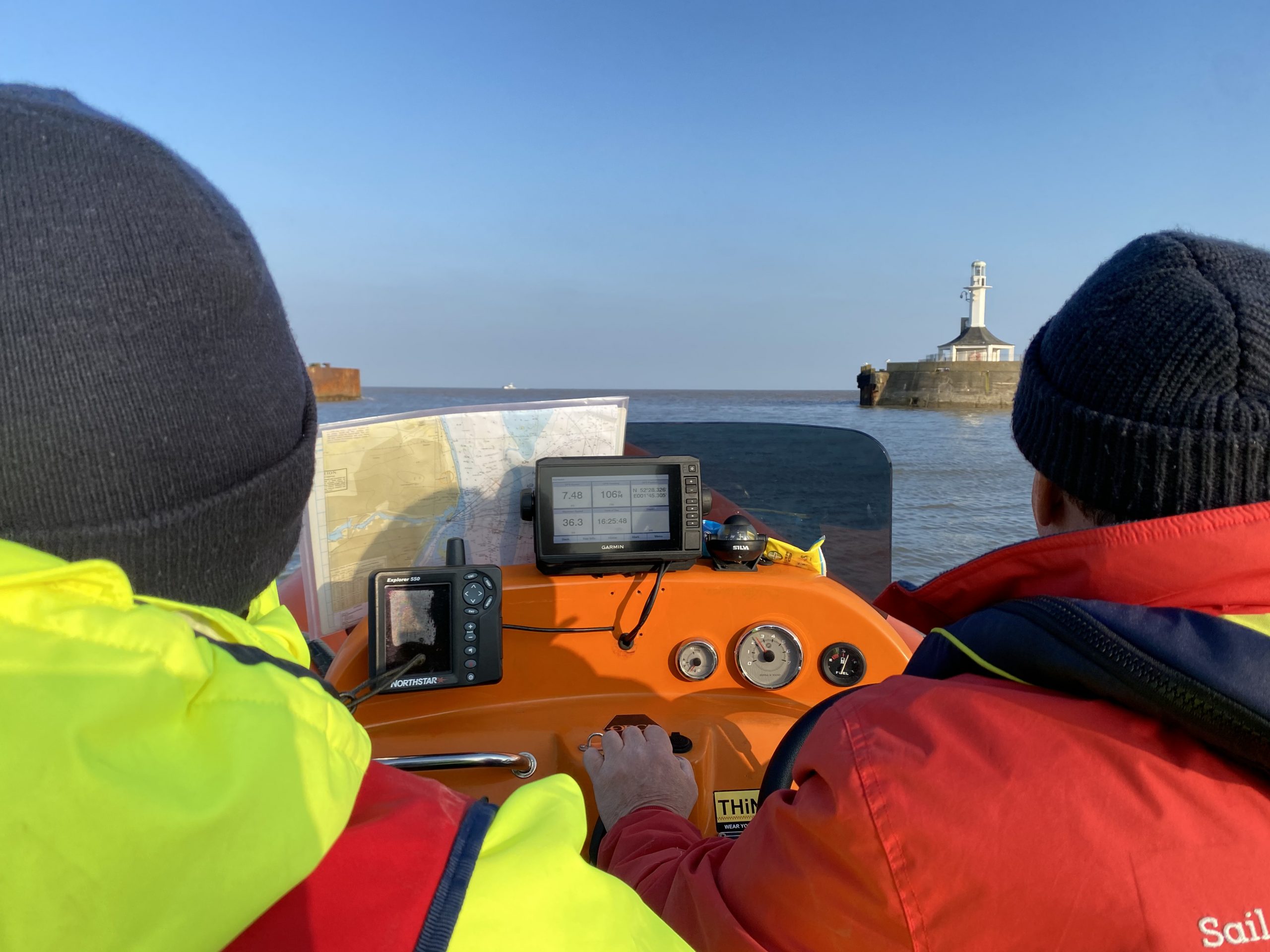
RYA Power Boat Level 2
This course suits those new to boating who want to develop the base skills as well as those who have boated for a while but who want to ensure they are approaching their boating the right way.
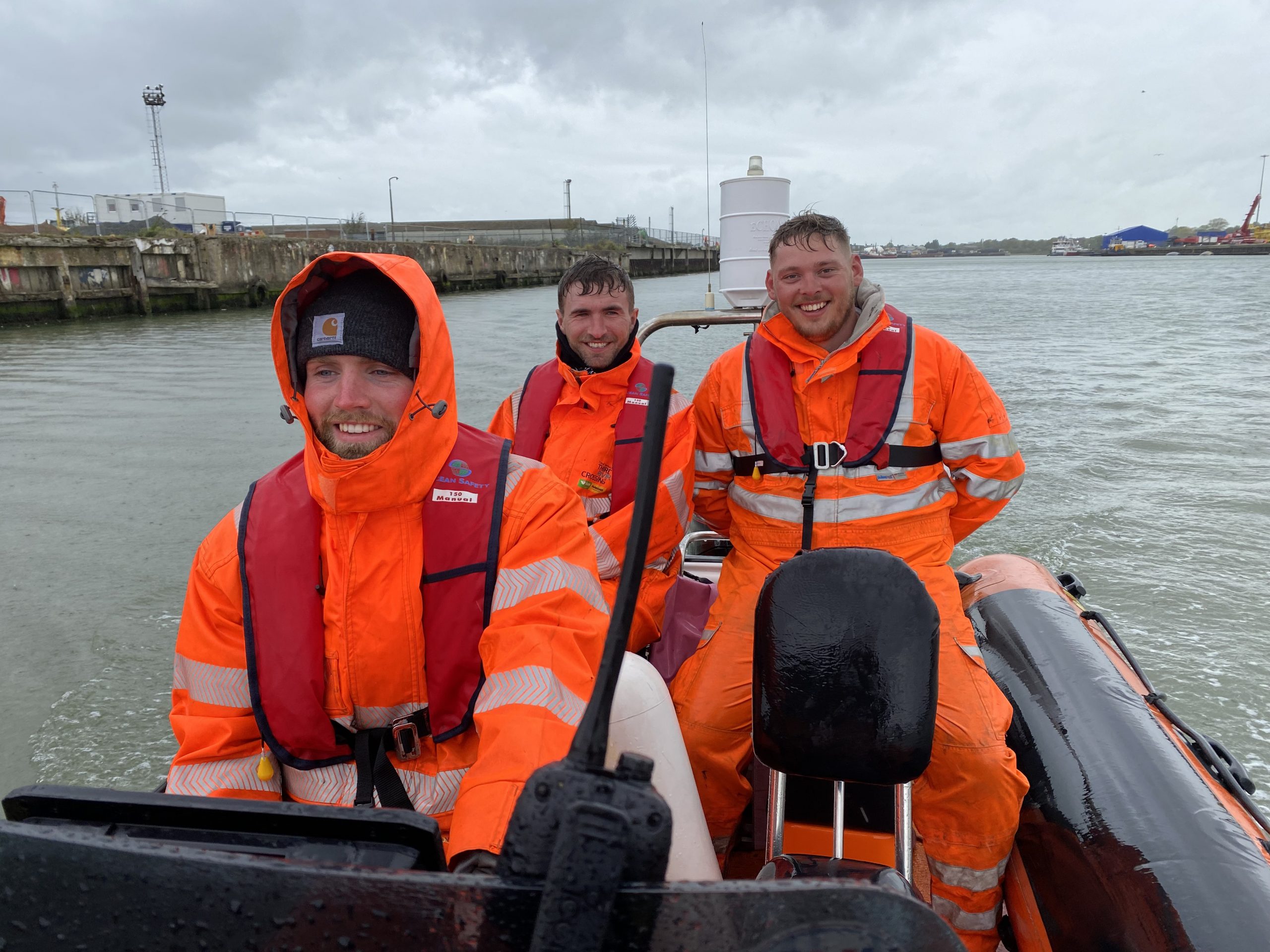
RYA Power Boat Intermediate
Thi course is aimed at those who have boated a season or more, probably already have Level 2 and want to learn more about coastal cruising.
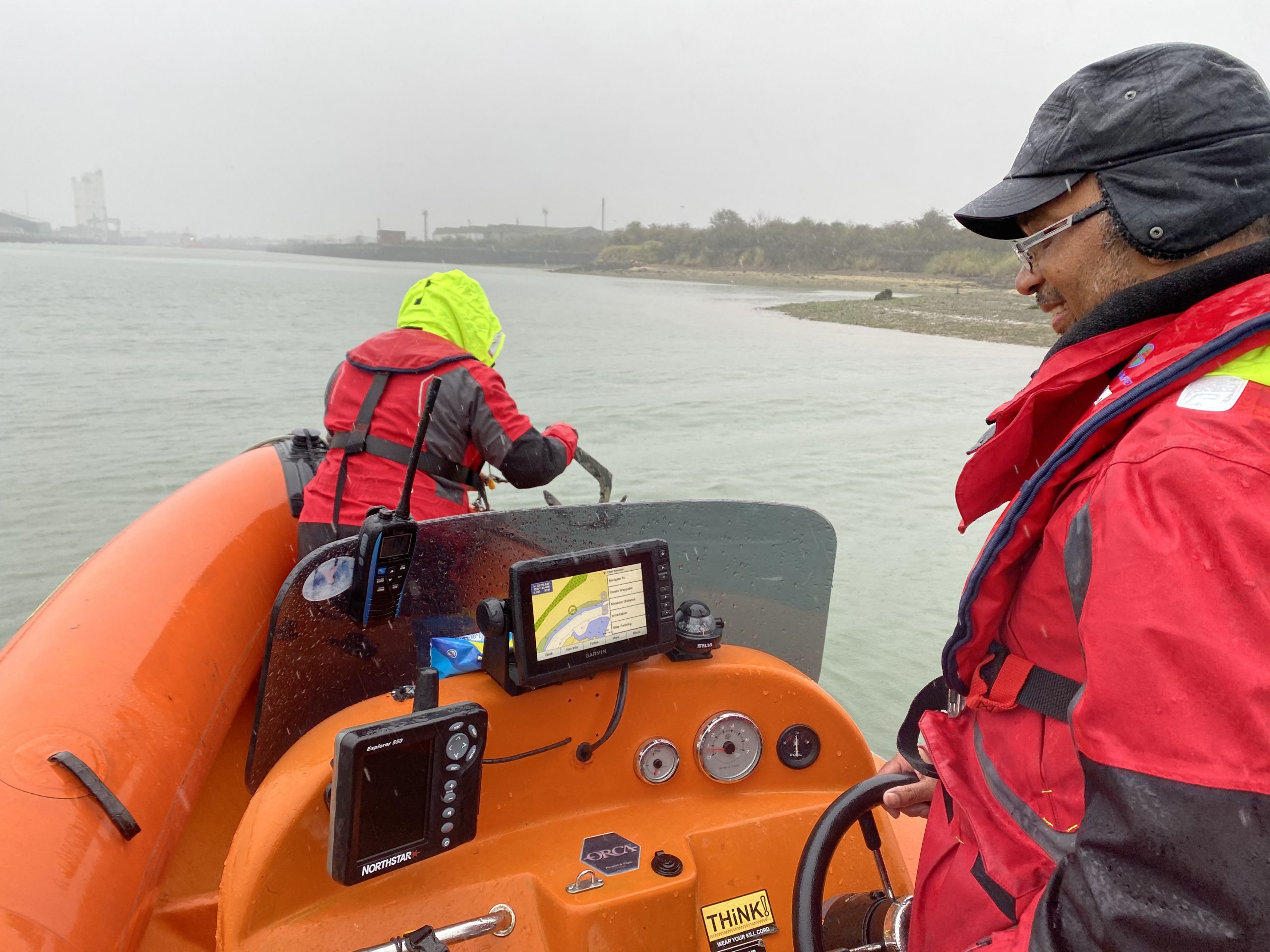
RYA Power Boat Advanced
Aimed at experienced leisure boaters and those seeking to work commercially. The Advanced Course can be followed by the Advanced Examination.
RYA Power Boat Advanced CoC Exam Prep
This will vary from person to person, but it is easy to underestimate the level that you need to be at for the Advanced Examination.
RYA Superyacht Tender Operator
Aimed at those already working as a tender driver transferring guests/passengers in sectors such as the superyacht world or in other environments where you may need to transfer guests and passengers.
International Certificate of Competence (ICC)
Frequently asked questions, most popular questions..
No prior experience is necessary to enrol in an RYA Powerboat Level 2 course. This course is designed for beginners and covers basic boat handling and safety skills.
Participants are typically required to bring appropriate clothing for boating, including a waterproof jacket and trousers, suitable footwear with non-slip soles although clothing is dependant on weather.
Yes, RYA Powerboat certificates are internationally recognized and accepted by maritime authorities and charter companies worldwide. The RYA is a leading authority in boating education, and its certifications are highly respected within the maritime industry.
RYA Powerboat Level 2 courses typically last two days. During this time, participants will receive both theoretical knowledge and practical training in boat handling, safety procedures, and navigation.
Not sure which course is for you?
Get in touch with our team and we can have a chat about your options to help you get the most out of our services and facilities.

Our Training Centre:
Royal Norfolk & Suffolk Yacht Club The Royal Plain, Lowestoft Suffolk, NR33 0AQ
Speak to us:
01493 253004 - training centre, 07775 581912 - course admin.
For Powerboat or Shore based course enquiries please email our Chief Instructor:
[email protected]
For non course enquiries please email our owner and training principal
[email protected]

- Subscribe Now
- Digital Editions

Training: What you learn on an RYA powerboat Level 2 course
Our News Editor recalls what he learnt on his first weekend of formal training at Mendez Marine on the River Hamble
While there’s no replacement for raw boating experience, there’s quite nothing like a weekend of boat training to drive home what you do and don’t know.
Having cut my teeth inland on much larger boats, refining the basics aboard a 5.8m RIB on Southampton water to get my RYA Powerboat Level 2 licence was an experience of fine margins and precise handling.
My hosts for the weekend were Hamble-based training centre Mendez Marine, which runs a range of courses for boaters of every level.
RYA Level 2 Powerboat is where many boaters start their training and while it is suitable for beginners, it’s no walk in the park.
In a group of three, alongside a 20-year veteran RYA Yachtmaster, I quickly embraced my role as the dunce of the class, regularly asking the stupid question.
Recommended videos for you
We began with the basics of wind and tide, and using these elements as your brakes when performing slow-speed manoeuvres. Next came Met Office forecast terminology and a quick rundown of the local bylaws.
Our instructor Kieran belied his years with two pieces of sage advice that I would later wish I had tattooed onto the inside of my eyelids: “Steer before gear, and keep one hand on steer and one hand on gear”.
The classroom section was necessary but mercifully short – the July sun was beating down and we’d come here to do some actual boating.
Out on the water
Kieran introduced us to Kake , our vessel for the day, with the fondness and respect that reflected his years growing up with boats of all sizes.
This Ribcraft powerboat was fitted out with GPS, VHF, a 140bhp outboard and a windscreen, which would come in handy during the high-speed thrills of day two.
After a quick orientation we cast off into a particularly strong spring tide and set about proving our mettle with some basic manoeuvres.
Holding off behind pylons and picking up a mooring buoy proved straightforward enough, but coming alongside was particularly challenging as the tide raced in.
The best way I can describe it to a non-boater is: imagine parallel parking a car on a slow-moving treadmill.
Kieran’s patient and encouraging attitude ensured we could all tick this off eventually, even if I took a few attempts to perform the manoeuvre without ferry drifting or bashing a sponsom against the pontoon.
Stopping for lunch back at base halted our progress up the Hamble, but we were relived to sit on a more comfortable seat.
While Kake was fitted out with everything we could need from a technical point of view, she was not built for comfort and the narrow seats meant that we were staggering like John Wayne after a two-hour stint on the river.
The afternoon’s activity started with turning in a confined space – a drill that really brought the whole ‘steer before gear’ principle into focus when the penalty for failure was bumping into a £2m superyacht.
The blazing sunshine had brought local river users out in their droves, and we were constantly reminded of the rules of the road as we navigated past sailboats, canoes, motorcruisers and paddleboarders.
Through it all Kake was highly responsive, much more so than I was expecting: it took a while to realise that small adjustments would be enough to change our course sufficiently.
With all our drills complete, we nipped back to our pontoon as low tide approached, thankful for our trim tilt and skeg-adjusted depth sounder as less than 1m of water remained at HQ.
We went our separate ways for the night, and while my boating skills had been given a thorough workout, I knew that the real fun had all been saved for day two.
Thrills and spills
A mercifully overcast second day saw us head out onto Southampton water for some high-speed action, and as Kake hit 4,000rpm and rose up onto the plane, I was reminded why I was doing this in the first place.
Nothing quite compares to the raw thrill of piloting a RIB at 25 knots. With the responsiveness of a rollercoaster and excitement to match, it’s easy to see why this is such a popular gateway to motorboating.
Kake ‘s unique characteristics came into play, as she smoothly turned to starboard but put up much more of a fight when turning to port.
The urge to grab the wheel with both hands was hard to resist, but Kieran’s second mantra ensured that we were never allowed to let go of the throttle for very long.
S-turns and powered U-turns were followed by tighter U-turns and P-turns, as we rode the considerable wash thrown up by sportsyachts and catamarans.
Once Kieran was satisfied that we knew how to do the fun stuff, we dropped anchor at Hythe for a lunch break and quick buoyage quiz.
One of the most useful things you can learn on a training course is what to do in an emergency and the man overboard procedure brought together everything we had learned so far.
Using a fender and a bit of clever distraction, Kieran simulated this worst case scenario and we were required to perform a P-turn before approaching upwind with the utmost precision to retrieve our tiny target.
The side-on drifting approach was also covered, by which time our sensei was satisfied that we could cope with a real-life MOB.
Hatching a plot
With chartplotters so commonplace these days it can be easy to neglect more traditional navigation skills, but this course ensured we could cope without such modern fripperies.
Classroom theory was put into practice as we took bearings from a compass to determine our exact location on the chart before following bearings that we’d mapped out in the morning to buoy hop our way back to the mouth of the Hamble.
Coming off Southampton water and back onto the river with its six-knot speed limit felt like turning off a motorway, and this led some to resort to impatient overtaking as we patiently cruised back to our berth before low tide.
I certainly felt a great deal of pride upon being presented with my certificate, and even though it is not a legal requirement unless your boat is more than 24m long, a course like this should be seen as an essential primer for any self-respecting skipper. I’m only ashamed I didn’t do one sooner.
Mendez Marine offers boat training ranging from VHF courses through to Yachtmaster exams. For more information, visit mendezmarine.co.uk or call 01489 588977.
Sunseeker Ocean 182 – see how this £9m superyacht copes in a wet and windy sea trial
Quarken 35 t-top first look: open-plan with pilothouse echoes, azimut grande 44 metri trideck first look, latest videos, delphia 10 boat tour: great value family cruiser, galeon 560 fly tour: the coolest flybridge ever built, cormate utility 27 tour: 80mph rocketship at a price you won’t believe.

- Our Community
- Our Dealers
- Book a test drive
- Buyers guide
A guide to RYA powerboat training for drivers
Whether you are a beginner or an experienced driver, there’s always something new to learn about being on the water.
Why should you consider powerboat training?
In most countries you have to pass a driving test and get an official licence before you can legally drive a powerboat or RIB. There’s no such requirement in Britain (except for very large yachts). Powerboat training and certification are voluntary. Although contrary to what you might expect there are actually fewer boating accidents in UK waters than in many countries that do insist on a formal driving licence.
That said, it’s extremely unwise to take to the water without any knowledge or training. There are plenty of pitfalls including some real potential dangers and many of them can’t be avoided with just common sense.
Boating is statistically very safe in Britain because most people get themselves trained to a higher level than the bare minimum required by a basic exam. The RYA’s (Royal Yachting Association) training scheme is the international gold standard for recreational boating and its certificates are widely recognised abroad.
Good reasons to get trained
There are many good reasons to sign up for at least one training course.
- First and foremost, you will definitely get a lot more enjoyment from your boating if you know what you’re doing – and so will your family and friends.
- If you own your own boat, your insurance premium will almost certainly be lower and your maintenance and repair bills are likely to be much smaller, too.
- A good working knowledge of tide, weather and sea conditions is absolutely essential for safe boating in coastal waters
- Aa training course will teach you some very useful skills, such as high-speed boat handling techniques and parking manoeuvres, which are difficult to figure out on your own.
- Just like driving a car, you need to understand the ‘rules of the road’ including some that aren’t obvious or intuitive.
- A boating certificate also enables you to hire boats and yachts on holidays abroad, charter a boat, or to take your own boat overseas.

Learn locally, or on holiday
There are RYA recognised Training Centres all around the UK. Also, you can do courses in places like Greece, Spain and the Caribbean, combining a hands-on boating course with a holiday and learn the essential skills in hot, sunny weather. Although if you plan to do the majority of your boating in tidal waters, it is worth doing a course in tidal waters. In the UK there are powerboat charter companies and boat sharing Clubs, many of which also offer approved RYA training as part of the induction process.
Most Training Centres are geared up to teach a whole family, either on the same course or on different courses appropriate to their age, knowledge and ambitions. A further option for boat owners, offered by some training centres, is to arrange private tuition from an RYA instructor on your own boat. The obvious advantage of this is that it allows you to learn and practice on the same type of boat that you’re going to be using.
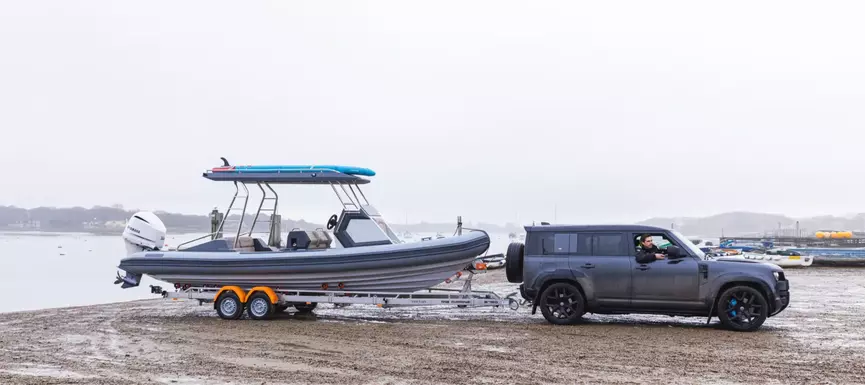
Beginners start here
The RYA scheme starts with two beginners’ courses: Level 1 Start Boating and Powerboat Handling Level 2. Neither of them assume any prior knowledge of boating. (Both courses are offered by Trafalgar Powerboat Training too!)
Level 1 is a one-day introductory session out on the water that covers the basics and gives you the knowledge and skills to drive a boat safely under the supervision of a more experienced person.
Level 2 is the course for you if you want to be independent and self-sufficient on the water. You don’t need to have completed a Level 1 course; you can go straight in at this level. It’s a two-day, hands-on course that covers the essentials you need to enjoy your boat safely in good weather conditions:
- launching & recovery
- boat handling and manoeuvres
- parking techniques – mooring, anchoring & coming alongside
- man overboard rescue
- and much more.
Most insurers expect boat owners to have a Level 2 certificate, or to demonstrate that they have equivalent experience. It’s also the minimum qualification for an International Certificate of Competence (ICC), which you will need if you want to drive boats and yachts abroad.
Essential boating knowledge
After passing your Level 2 course the next step, if possible, is to practice the skills you’ve learned and get some experience. This may be in your own boat, on a holiday or as a member of a shared boating club such as Boat Club Trafalgar .
At the same time, you can start preparing for the RYA Day Skipper course. This is a ‘shore-based’ boating theory course that equips you with the essential knowledge and practical skills needed to confidently and safely navigate your boat:
- weather forecasting
- collision avoidance
- emergency and safety procedures
There’s a lot to learn: about 40 hours of teaching followed by two exam papers. The Day Skipper course can be taken either as a series of short sessions, by distance learning online or as a one-week intensive course. It might seem like a bit of hassle, yet so much crucial and useful knowledge is packed into in this course that it really is worthwhile. Most people tend to do it in the winter months in preparation for the next season.
Intermediate and advanced courses
The next practical on-the-water training course in the RYA scheme, Intermediate, is a two-day session geared towards people who want to go off cruising in large motor yachts and drive high-performance powerboats. The course syllabus assumes that you already have the practical skills and experience of Level 2, plus all of the knowledge that’s covered in the Day Skipper course. It’s strongly recommended that you also have a first aid certificate and a marine VHF radio operator’s licence.
The Intermediate course content includes:
- cruise planning
- boat preparation
- practical pilotage and navigation
- more advanced boat-handling and manoeuvring techniques
- more rigorous man overboard rescue training
An advanced boating theory course called Coastal Skipper/Yachtmaster Offshore follows on from Day Skipper, with another 40 hours of learning and three exams. You’ll need to do that (or at least have the equivalent level of knowledge) before tackling the Advanced practical powerboat course. This is the course for adventurous boaters and for professional boat drivers, training you for:
- longer trips
- navigation at night
- boat handling in challenging weather and sea conditions
The Advanced course is arguably a bit more advanced more than the average leisure RIB or powerboater actually needs. However, it’s highly recommended if you’re planning to go off on an extended cruise.
Specialist skills and informal training
The RYA also offers a range of short, specialist courses that are very useful for some types of boating. These include subjects like radar, sea survival, first aid, VHF radio and diesel engine maintenance.
Most RYA Training Centres can also offer informal training on request – perhaps a one-day refresher course if you haven’t been on the water for a while, or a boat-handling session if you’ve plenty of experience in other types of boats but are either new to fast powerboats and RIBs, or want a session in your own boat.
However, much training you have, it’s no substitute for going out on the water and building up hours and days of practical experience, driving your own boat or other people’s.
Even after years of doing it, you’ll find that you still keep learning. And that’s what makes it so rewarding.
For more information on RYA training courses, visit RYA.org.uk .
Subscribe to our newsletter
© 2023 Leisure & Commercial RIBs by Ballistic RIBs All rights reserved. | Privacy & Cookies | Data Request
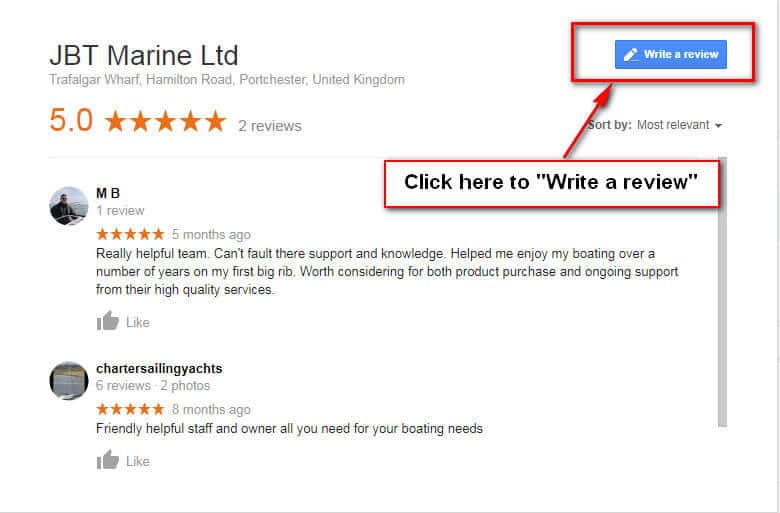
- How it works
- Frequently asked questions
- General information
- The coordinator

RYA Powerboat level 2
Course offered by simon.
- Plan RYA Powerboat Level 2 Course Plan Day 1: - Start with a Safety Briefing: Attention is crucial as you'll need to conduct a briefing yourself during the course. - Detailed Look at Safety Equipment Onboard: Discuss legislation related to first aid kits, flare kits, etc. Understanding legal compliance is essential and will help you avoid serious fines in Spain. - Procedure for Starting the Engine and Casting Off: Learn how to start the engine and unmoor the boat. - Coffee Break. - Practice in the Port of Denia: Perform slow-speed maneuvers, including forward and reverse movements. Focus on reverse gear control, effects of wind and tidal current, turning the boat, and understanding the pivot point. - Break for Lunch. - Practicing Coming Alongside and Leaving a Mooring: Includes both Mediterranean mooring and the fuel dock, with close turn practices. - End the Day with Theory: Navigation, chartwork, and COLREGs. Day 2: - Start with Coffee and a Working Breakfast: Plan a coastal passage. Some more theory including buoyage and weather. - Onboard Review of Electrical and Electronic Systems: Learn to use the plotter and radio. - Review of Previous Day with Extra Practice: For those who need additional practice. - Leave Port and Practice Navigation. - Execute the Planned Passage: Navigate the coast from Denia to the San Antonio Lighthouse. Learn to fix position using traditional navigation tools like the handbearing compass and chart. - Practice Mooring to a Buoy and Lunch Break: Lunch on the boat. - After Lunch, Return to Denia: Practice planing techniques (speed control, turning), and anchoring north of the breakwater. Afternoon focused on emergency procedures, including man overboard recovery techniques. - Return to Port for Debriefing and Boat Clean-up. - Certificate Ceremony for Successful Candidates. The course lasts 2 full days. Each day starts at 09.00 and finishes at 17.00. Read more
Boat details
- Model: Bénéteau - Flyer 8 Spacedeck
- Capacity: 8 spots
- Length: 10.00 m
- Bathrooms: 0
- Life jackets
- Electric windlass
- HI-FI equipment
- Equipo de snorkel
Additional Information
- Certificates
- Food and drink on land
- Credit/debit card
- Wire transfer
5 · 1 review
- Start: 25 May. SaSu from 09:00 to 17:00 3 places available 545 € Book now
- Start: 8 Jun. SaSu from 09:00 to 17:00 3 places available 545 € Book now
- Start: 22 Jun. SaSu from 09:00 to 17:00 3 places available 545 € Book now
Other activities published by Simon

- We call you
- Contact Simon Direct message to the person in charge of the activity
- Write us by WhatsApp Talk to us at +39 065 326 613 4
- Contact Form We write your needs or doubts
- Shall we call you? Leave us your number and we will call you
Important Notice
You are using an out of date version of Internet Explorer!
This browser may prevent this website from displaying and functioning as intended.
Please click here to upgrade.

Late notice spaces available for selected courses - click here for details
RYA Powerboat Level 2
Price: from £299 (Finance now available)
Location: Starts from our base at Premier Gosport Marina
Duration: 2 days
The perfect introduction to Powerboats & Ribs, the two day RYA Powerboat Level 2 practical powerboat course will give you the best building blocks to kick-off your powerboat adventure from!
Take a look at our live course calendar for dates for the RYA Powerboat Level 2 course!
Booking details
Please select your preferred start date below.
- Saturday 25th May 2024 (2 spaces)
- Saturday 8th June 2024 (3 spaces)
- Saturday 22nd June 2024 (3 spaces)
- Saturday 6th July 2024 (3 spaces)
- Saturday 20th July 2024 (3 spaces)
- Saturday 3rd August 2024 (2 spaces)
- Saturday 17th August 2024 (3 spaces)
- Saturday 31st August 2024 (3 spaces)
- Saturday 14th September 2024 (3 spaces)
- Saturday 28th September 2024 (3 spaces)
- Saturday 12th October 2024 (3 spaces)
- Saturday 26th October 2024 (3 spaces)
- Saturday 9th November 2024 (3 spaces)
- Saturday 23rd November 2024 (3 spaces)
- Saturday 7th December 2024 (3 spaces)
Course Information
Joining Instructions: Please click here for course joining instructions
Recommended Reading: Sailing magazines and newspapers, but this is not essential
Course Prerequisites: No assumed knowledge
Minimum Age: No minimum but Under 16’s must be accompanied by adult. Persons aged 16+ can be unaccompanied subject to other pre-requisites having been met
Who is the course for:
The RYA Powerboat Level 2 course is designed for anyone who wants to start their exciting and adventurous powerboat journey the right way!
With little or no prior knowledge of being on a RIB, the two-day RYA Powerboat Level 2 course will give you the building blocks you need to start your journey.
With training from qualified RYA instructors on board our boat, this 2 day beginner / novice friendly course runs all year round at our RYA Training Centre with immediate access to the open water of the Solent

What we cover on the course:
This course is perfect for when you go on holiday and hire a small powerboat to nip from port to port, or explore those secluded beaches and bays in those hot climates.
This course teaches the basics of boat handling, safety and navigation, and skills at planing speed.
The Powerboat Level 2 course gives you a comprehensive grounding and a good skill-set that will put you in good stead to skipper a powerboat on your next boating trip.
Our RYA Powerboat Level 2 courses have a ratio of three students to one Instructor.
During the course you will cover:
- Collision regulations and rules of the road
- Knowledge of safety equipment
- Turning in confined spaces and close quarter handling
- Coming alongside a pontoon and securing to a mooring buoy
- Man overboard techniques
- Planing speed manoeuvres
- Pilotage and passage planning
This course is suitable for anyone with or with out boating experience as this covers the basics of what you need to safely take you and your family / friends out for a days powerboating.
In the UK or abroad with the Powerboat level 2, it will allow you to convert the certificate into the International Certificate of Competence (ICC) which is what you need to charter a boat outside of the UK.
It’s the perfect course for getting into boating and putting a toe in the water.
Course formats & details:
Courses run in a choice of two formats:
- 2 consecutive days – Between Monday – Friday
- Weekends – Saturday & Sunday
Fancy going VIP and having your own exclusive private course for you and your friends or family? You can book the whole powerboat just for your own exclusive course from only £299 per person. Enjoy the course in style, with up to three persons on the boat being taught by one of our friendly, experienced RYA qualified Instructors! What a way to start your powerboat adventure!
Our Chief Instructor says this about the RYA Powerboat Level 2 Course:
This is the perfect course for getting into the world of powerboating.
The course will give you the ability to charter a powerboat, or just get some all-important confidence to venture out on your own.
Learning the basics of navigation and boat handling, this is the best course to start with.
Once you have this under your belt, you can hire powerboats and take family and friends out for the day.
It allows you to explore the coastlines and harbours.
Why not pop down to our Gosport Marina base, hire a powerboat, then head to the Isle of white and have a nice lunch at some of the amazing restaurants that the island has available for you to sample.
This really is a gateway ticket to powerboating and getting you out there on the water.
Related courses
Rya powerboat advanced.
Coming Soon!
RYA VHF/SRC Radio
The RYA SRC/VHF Radio Course is minimum qualification required by law to operate the VHF or VHF Digital Selective Calling (DSC) equipment on any British flagged vessel carrying a radio.
Take a look at our live course calendar for dates for the RYA SRC/VHF Radio course!
Petrol Engine Maintenance
The Petrol Engine Maintenance Course is a great introduction into maintaining your boats petrol outboard engine, and understanding how it works. A must have for any sailor looking to buy a boat, or already has one!
Take a look at our live course calendar for dates for the Petrol Engine Maintenance course!
Customer reviews
A fantastic weekend of sailing, almost 130 NM in all, with a relaxed, but fully engaging skipper. Great set up and brilliant on the admin. Thanks Stef, Tom et al!
I did a weeks coastal skipper course getting ready for my yacht master and I have to say it was one of the best training weeks I’ve had - our training instructor was superb, exactly the sort of person that you want. He could inspire, provide discipline and impart knowledge as well as let you learn through your own mistakes. Tom and Steph run an excellent operation there and I highly recommend it. They’re flexible and very helpful when it comes to your journey into being a qualified sailor.
Subscribe to our newsletter for the latest news & offers

Back to Basics – Part 1: The ‘COLREGs’
In this series of articles, paul glatzel takes us back to what you might call ‘the essentials of boating’..
In the pages of PBR we host an amazing array of boats, but there’s no point having a great powerboat if you don’t know how to use your chartplotter and understand the charts they are built on so you can safely go to all the fun and interesting places. You’ll have to appreciate how tides affect you and the best place to find the appropriate information. And of course, in any waterway – and especially the busy ones – you must know how to avoid collisions with other craft and what the rules are that you need to apply. While this series of articles is aimed primarily at those starting out, we’re sure that even the pros among you will learn a thing or two during this series. We hope that you enjoy it. This article is also of great use for those considering the RYA Powerboat Level 2 as a boating course.
Avoiding Collisions
So let’s start with avoiding collisions. The rules around this tend to be referred to as the ‘COLREGs’. They are pretty simple, and for me, one of the really key ways to keep you and those you boat with safe is to work as a team on board. Yes, the buck stops with you as skipper , but engage your crew and especially the kids. Youngsters are brilliant and love pointing out the presence of other craft that may present a risk of collision – keep them busy and keep them keen!
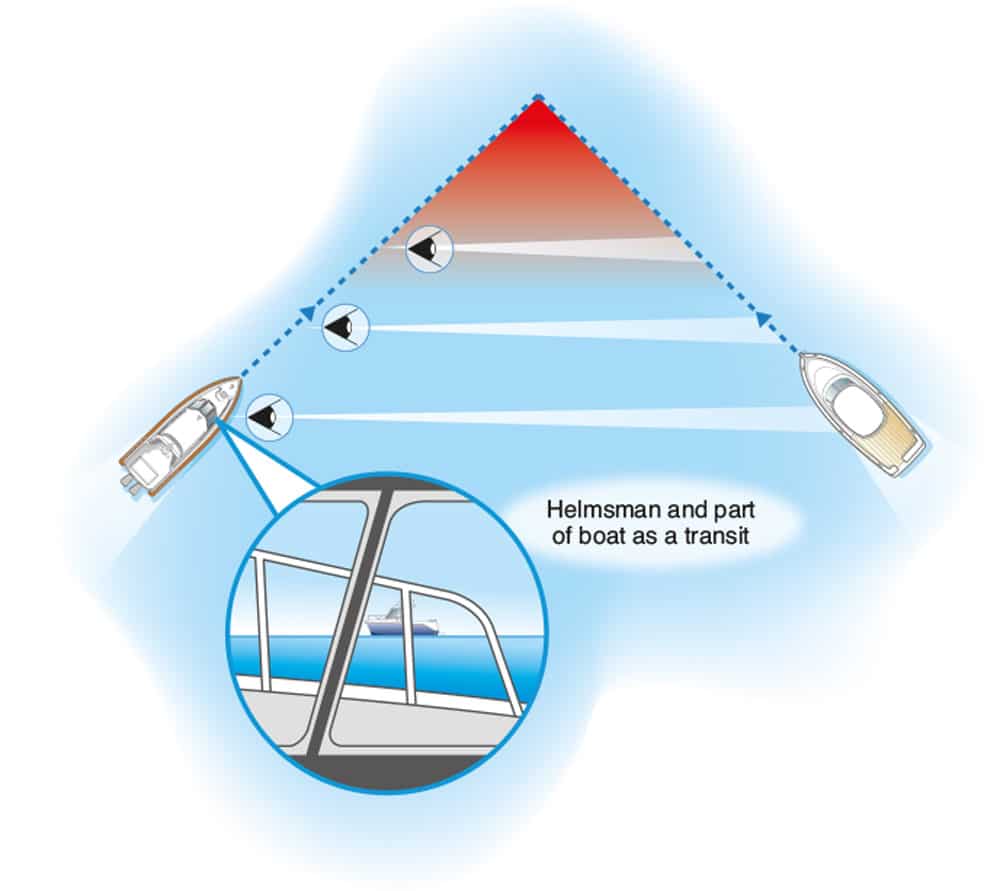
Assessing risk of collision
The rules you would learn as part of a boating course, start with the message that they always apply to us all, and that we must do everything in our power to avoid a collision. They make clear that there’s no such thing as a ‘right of way’, and that whatever the rules say, the moment it looks like there could be a collision you need to be ready to take appropriate action.
So, what would a Powerboat Level 2 course teach you? Obviously you need to keep a ‘proper lookout’ so you can detect other craft. Yes, of course, this will mean using your eyes, but don’t forget to use your ears too, as so often I find that in busy locations you pick up many close vessels through sound. Use your crew as well – tell them to alert you to moving craft and consider using the clock face: for example, ‘windsurfer, fast left to right at your 10 o’clock’. If you have radar , then in certain situations you’ll be obligated to use it. Realistically, however, while at first glance radar may look simple, it actually isn’t as easy as it looks, so if you have one, do a course so you fully understand its use and potential.
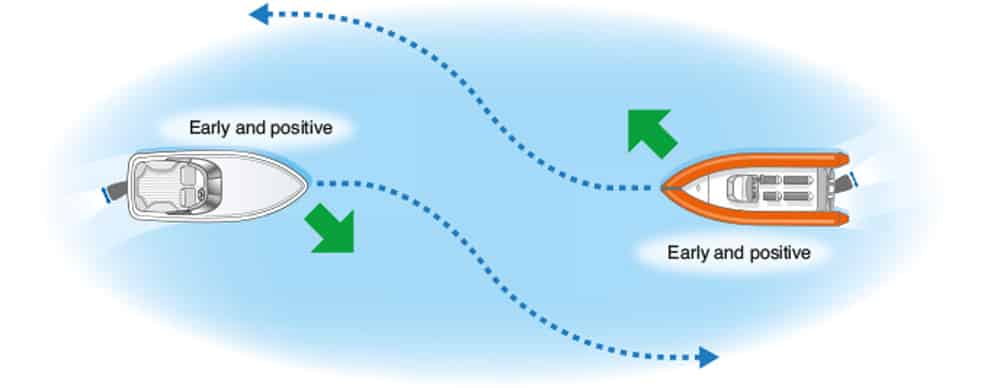
When we’re out there on the water we need to choose a ‘safe speed’ so that we can always react in time to a potential collision situation. Many factors could influence what a safe speed is, but the obvious ones are simple – the number of craft around, weather and sea conditions, depth of water, etc. In harbours or estuaries there may be speed limits, but beyond those areas it’s all about ‘safe speed’ and you being able to justify the speed that you were doing.
As we spot other vessels, we need to determine whether they present a risk of collision. The way we do this is simple. If a vessel remains on a ‘constant bearing’ to us, whether ahead of us or coming from our left or right, there’s a risk of collision. In reality, we rarely tend to take an actual bearing but just line up a couple of points on our boat with the other craft. If this line to the other craft stays the same, we are heading for a crash and must apply the rules to avoid a collision. (See collision diagram)
We then need to consider what sort of vessel we are facing, which will determine what we need to do. If it’s a power-driven craft (big or small), there are some specific rules we need to follow (see below). If it’s anything else (e.g. a vessel under sail, a kayak, a vessel constrained by its draught, a vessel restricted in its ability to manoeuvre), we need to give way to them. The rules are not clear on how we should do this, so basically we tend to ‘turn to the right’ – unless, of course, that takes us into danger, in which case we should turn whichever way seems safest. It makes real sense to slow down too. Reducing speed buys you time to think and reduces the chance of a collision.
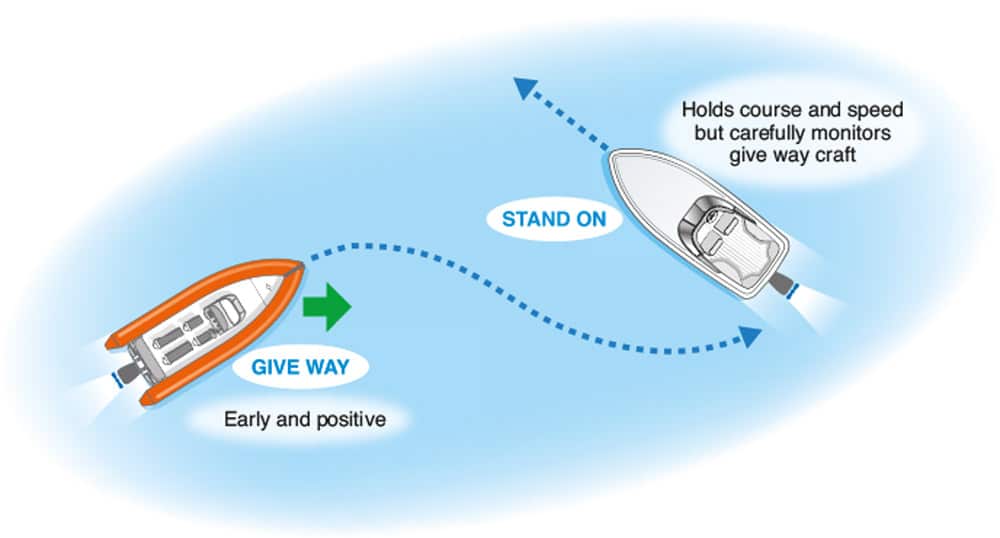
Crossing: The give-way craft needs to turn to the right (starboard) to pass behind the stand-on one.
For power-driven vessels there are two key situations.
If we are ‘head-on’ to another power-driven vessel (‘PDV’), both craft are termed ‘give-way’ and both must make early and obvious turns to the right. (See head-on diagram)
Crossing situation. If a PDV is approaching from between (roughly) your 12 and 4 o’clock, your vessel is the ‘give-way’ one. The other craft is ‘stand-on’ and needs initially to hold course and speed. However, those on the stand-on boat need to keep a really good eye on the give-way one to ensure it does what it needs to. The give-way craft needs to turn to the right (starboard) to pass behind the stand-on one. (See crossing diagram)
The final situation to have a look at is ‘overtaking’. This is where power-driven and sailing vessels can fall out. So often we hear that ‘power gives way to sail’ and most of the time that’s true. It’s the ‘overtaking’ situation where things are different, though. If a boat is approaching from between roughly your 4 and 8 o’clock, they are ‘give-way’ and you are the ‘stand-on’ vessel. The overtaking craft can pass on either side and must be careful to get well past you before they cut back in front of you. If you think about it, it’s logical that if a sailing vessel is overtaking you, they are give-way. They are faster and know which side they can go, so it makes sense that they are the give-way craft. So power doesn’t always give way to sail! (See overtaking diagram)
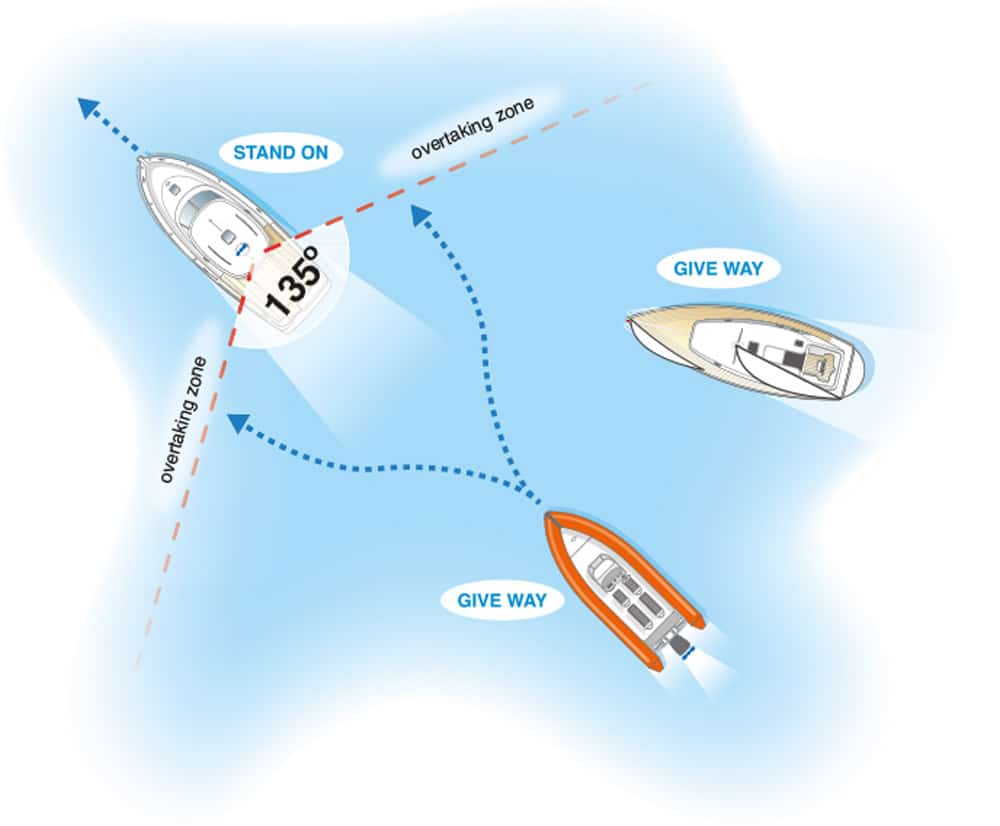
Overtaking: The overtaking craft can pass on either side and must be careful to get well past you before they cut back in front of you.
In summary, the rules are pretty straightforward, but you need to know them and apply them. For me, the one really key thing to look at doing is slowing down. So many collisions occur because a skipper is uncertain what’s happening and has little time to make a decision. Slow down and buy yourself some time.
Keep safe and have a great time afloat!
Check out Powerboat and RIB TV Paul Glatzel and TMS discuss all aspects of getting afloat. The RYA Powerboat Handbook and the RYA Advanced Powerboat Handbook are available in print or as e-books from Amazon or the RYA shop at rya.org.uk/shop .
Read the full Back to Basics Series:
Back to Basics Part 2: Interpreting your Charts and Chartplotter
Back to Basics Part 3: Tides
Back to basics part 4: buoys and pilotage, back to basics part 5: boat handling.
Learn more in our Tuition Section
Share This Story, Choose Your Platform!
Related posts.
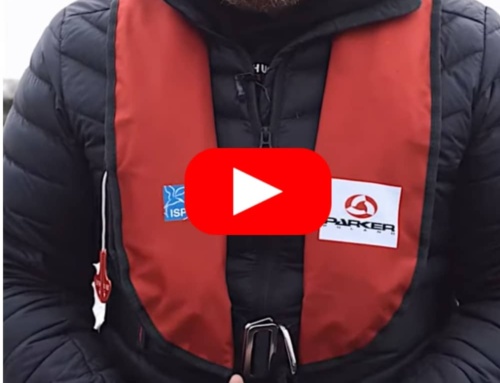
Top Tips Video Series: Life Jacket Safety
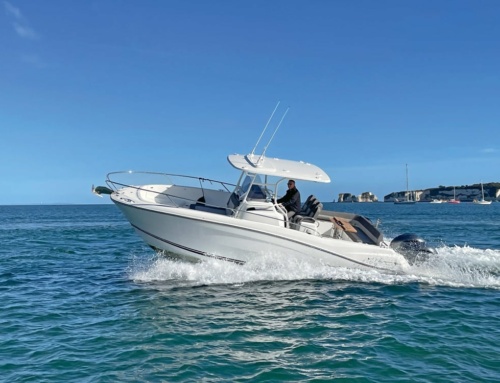
Top Tips Video Series: On Board Must Haves
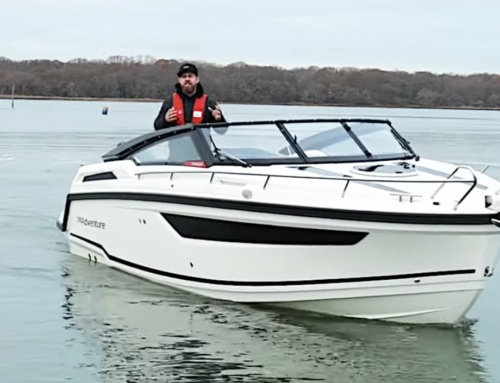
Top Tips Video Series: Are You a New Boater Looking for Some Top Tips to Get Started Boating?

Subscribe to the PBR Newsletter
Get all the latest news, reviews and exclusives, direct to your inbox
By clicking subscribe, you agree to receive news, promotions and offers by email from PBR. Your information will be used in accordance with our privacy policy .

RYA Powerboating
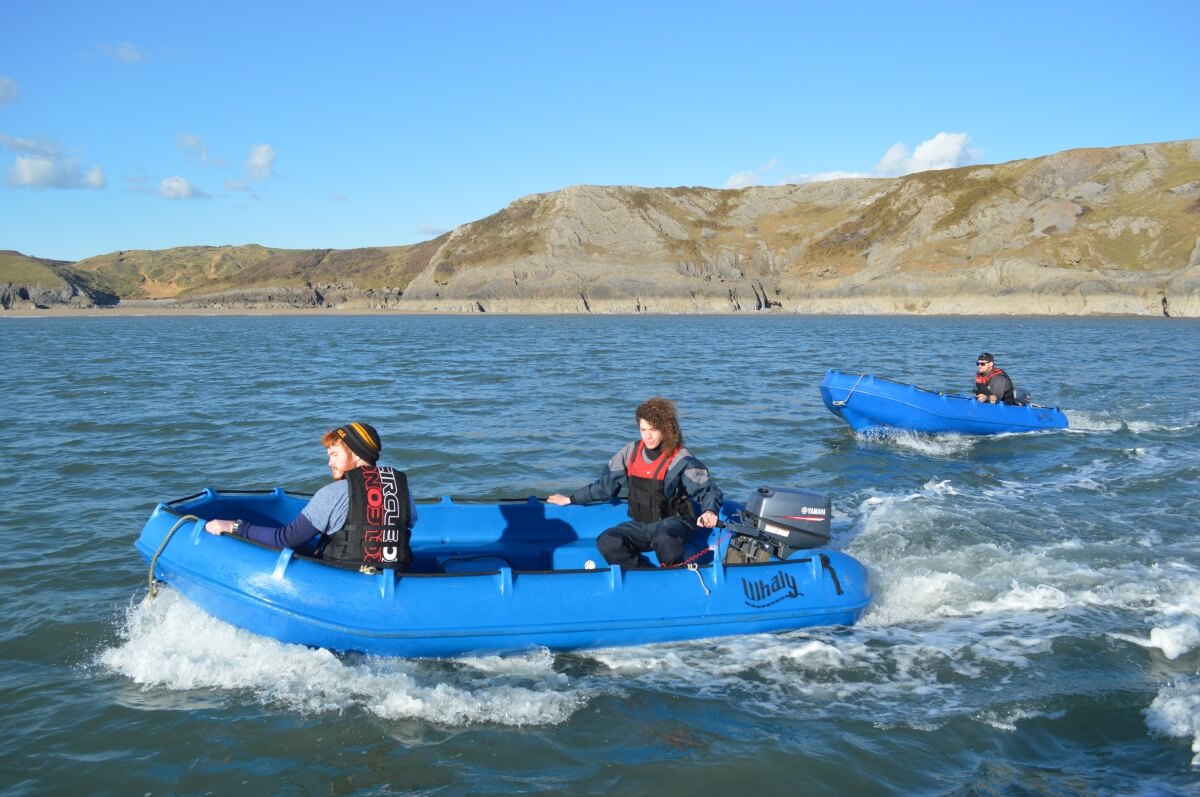

COMMENTS
RYA training will give you the confidence and skills to handle the boat safely and make the most of your time on the water, whatever your pace. As well as courses for recreational boaters, RYA powerboat certificates are also used by professional open boat skippers who need to prove their competence or require professional qualifications for ...
Powerboat Level 2. None. May be preceded by Level 1 Start Powerboating. All you need to know for self-sufficient powerboating at a basic level. Course includes launching, mooring, anchoring and recovery plus all the boat driving skills required for basic competence in a powerboat. 2 day course or shorter assessment for experienced drivers (half ...
Provides the skills and background knowledge needed by the competent powerboat driver and is the basis of the International Certificate of Competence. It aims to teach boat handling and seamanship in powerboats. ... RYA Powerboat Scheme Syllabus and Logbook (Book) (G20) £7.99. Add to Basket . RYA Powerboat Handbook (Book) (G13) £18.49.
Boating Level. safety, boat A basic understanding of 1 None handling and basic theory powerboating. Close quarters boat Able to handle a handling, planing speed powerboat in familiar. Level 2 None manoeuvres, man overboard waters by day recovery and collision regulations. Boat handling to Level 2 Daytime navigation skills, Able to navigate a ...
Emergencies (Theory): Cold Shock and Immersion Hypothermia. Distress Signals: Means of issuing distress including DSC and VHF Mayday calls. Disabled craft. Emergency Action to prevent sinking. Fire precautions & fire fighting. Advice for vessels in restricted visibility. marine-education.co.uk. +44 (0) 1202 024111.
Either 2:1 or 3:1. What's included. You will be coached over the full RYA course syllabus. Tea and coffee plus yummy biscuits. RYA Start powerboating book. SPBT note book. Free Parking. All mooring fees, safety equipment and fuel. There are some RYA books that go alongside the relevant powerboat courses which are available to purchase from ...
the 'nitty gritty': Remember there are x 41 I.R.P.C.S. / Col Regs rules.. these are just some of them. We've included the rules that are most relevant at the standard of RYA Powerboat Level 2 and RYA PWC (jetski) Proficiency etc. Rule 5 - Lookout. Every vessel shall at all times maintain a proper look-out by sight and hearing as well as by all ...
Mendez Marine offers boat training ranging from VHF courses through to Yachtmaster exams. For more information, visit mendezmarine.co.uk or call 01489 588977. Our News Editor recalls what he learnt on his first weekend of formal training at Mendez Marine on the River Hamble.
The RYA Powerboat courses thoroughly cover these rules and regulations of the water, and a lot more. These rules are also taught during our other RYA theory courses which go well together with our powerboating courses to develop personal knowledge and skills further, helping you become a safe, responsible and competent sailor/boater.
Specialist skills and informal training. The RYA also offers a range of short, specialist courses that are very useful for some types of boating. These include subjects like radar, sea survival, first aid, VHF radio and diesel engine maintenance. Most RYA Training Centres can also offer informal training on request - perhaps a one-day ...
RYA Advanced Powerboat Course Course Pre-Requisites: • Minimum Age: 17 years • Theory Knowledge to the level of RYA Yachtmaster Offshore • High level of powerboat handling skills Syllabus: Preparation for Sea & Safety • Preparation of powerboat & crew Boat Handling • Picking up & leaving a Mooring Buoy • Man overboard • Marina Work: Berthing & leaving in various conditions ...
The RYA Powerboat level 2 is a two-day, entry level course that will give you the background knowledge and boat handling skills you need to safely drive a powerboat, including low speed techniques and driving at planing speed. RYA powerboat courses are aimed at drivers of small powered craft such as sports boats and RIBs, that don't generally undertake long or offshore passages. What you'll ...
RYA Sea Survival Manual or "Personal Survival at Sea" booklet, e.g. MCA Booklet MCA/075 TCP3 Maintenance manual for lifesaving appliances The manual should contain instructions for on board maintenance of the lifesaving appliances and may include: A checklist for use when carrying out the required inspections
RYA Powerboat Level 2. Price: from £299 (Finance now available) Location: Starts from our base at Premier Gosport Marina. Duration: 2 days. The perfect introduction to Powerboats & Ribs, the two day RYA Powerboat Level 2 practical powerboat course will give you the best building blocks to kick-off your powerboat adventure from!
This article is also of great use for those considering the RYA Powerboat Level 2 as a boating course. Avoiding Collisions. So let's start with avoiding collisions. The rules around this tend to be referred to as the 'COLREGs'. They are pretty simple, and for me, one of the really key ways to keep you and those you boat with safe is to ...
RYA Advanced Powerboat Introduction The default first aid training required for those holding any RYA instructor qualifications or commercial endorsements is the RYA First Aid course. This course is widely available and designed for the specific demands of providing first aid afloat. It is also accepted by the Maritime
Speak to an advisor on +44 (0)1983 203001 or email us. The RYA Powerboat Level 2 is a 2 day course which covers the theory and practical skills needed to become a competent powerboat driver. Book your place now.
RYA Powerboating Level 1 Duration: 1 day, £240. Course information and content. The Powerboat level 1 course is a basic introduction to Powerboating. The course includes: boat preparation; boat handling at slow and high speed; mooring alongside and on a buoy; launching & recovering off a trailer; safety, and basic rules of the road
An RYA Day Skipper Shorebased or higher Course Completion Certificate can be used to validate the coastal waters category only. A shorebased certificate on its own is not sufficient. ... Where the applicant has demonstrated that they are competent to drive a larger powerboat, motor cruiser or barge, the 10m restriction is lifted and the ICC ...